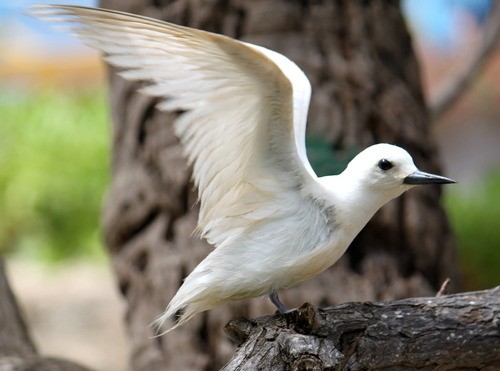White Tern
A species of White Terns, Also known as White Noddy, Angel Tern Scientific name : Gygis alba Genus : White Terns
White Tern, A species of White Terns
Also known as:
White Noddy, Angel Tern
Botanical name: Gygis alba
Genus: White Terns
Content
Description People often ask General Info
Description
The white tern has a wingspan of 76–87 cm (30–34 in). It has white plumage and a long black bill. Nesting on coral islands, usually on trees with small branches but also on rocky ledges and on man-made structures, the white tern feeds on small fish which it catches by plunge diving. 
Size
28-33 cm (11-13 in)
Colors
Black
White
Life Expectancy
17 years
Nest Placement
Tree
Feeding Habits
White Tern, primarily a fish-eater, captures its prey through plunge diving. It has a diet specializing in small fish, showcasing unique aerial hunting skills without any major dietary variations.
Habitat
White Tern generally inhabits tropical and subtropical oceans and is closely associated with coastal and oceanic islands across a broad geographic range. Its habitat includes both pelagic and epipelagic zones, venturing into wooded areas on islands for breeding. Typically nesting in trees, bushes, and on rocky slopes or cliffs, white Tern has also adapted to breed on artificial structures. These birds forage over open ocean waters, often near their breeding colonies, and are known to travel considerable distances in search of food.
Dite type
Piscivorous
People often ask
General Info
Feeding Habits
Bird food type
Behavior
This species is notable for laying its egg on bare thin branches in a small fork or depression without a nest. This behaviour is unusual for terns, which generally nest on the ground, and even the related tree-nesting black noddy constructs a nest. It is thought that the reason for the absence of nests is the reduction in nest parasites, which in some colonial seabirds can cause the abandonment of an entire colony. In spite of these benefits there are costs associated with tree nesting, as the eggs and chicks are vulnerable to becoming dislodged by heavy winds. For this reason the white tern is also quick to relay should it lose the egg. The newly hatched chicks have well developed feet with which to hang on to their precarious nesting site. It is a long-lived bird, having been recorded living for 42 years. 
Distribution Area
The white tern ranges widely across the Pacific Ocean from the coasts of Chile and Colombia to New Zealand and along the eastern and southern coasts of Asia from China to India, South Maldives, the islands of the Indian Ocean, and the coast of South Africa. Rarely it is also found in Japan, Madagascar, Mexico, and on some islands in the Atlantic Ocean. It is a pelagic and epipelagic bird, living along the coast and moving into wooded areas during the breeding season. 
Species Status
Not globally threatened.
